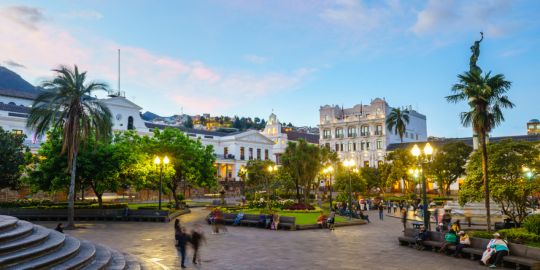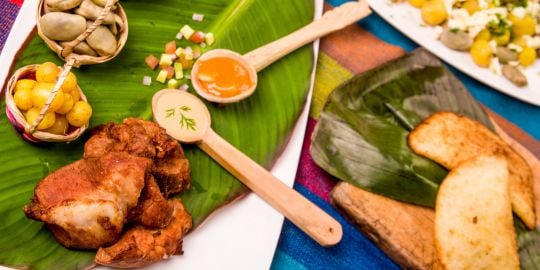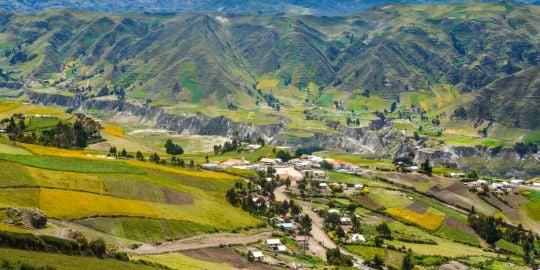From time to time I read comments about Ecuadorian beef. IMO it's delicious, but it's important to get the right cuts.
A lot of progress has been made the past three years. This industry like so many others has improved a lot. They are aging beef better, and obviously other methods because the quality has improved.
Okay, I'll give my input and I hope other members will share what they know. The following cuts are my favorite.
Lomo de afuera, this cut costs about $12 a kilogram and it's great for seco de carne, pepper steak, and beef curry. It's soft, and cooks real fast. Don't use a pressure cooker with this cut as it will over-cook it. It's also great for Chinese dishes like beef and broccoli. They mainly use this cut here for asado (bbq). They make slices in it, then season and toss it on the grill.
Served with chimichurri sauce, and a cold beer = perfect bbq.
T-Bone steak – the best is the export quality brand (cortes especial), you can identify it by the vacuum sealed packaging that has an image of a calf. It costs a bit more than ordinary T-bone but well worth the price. Juicy and delicious.
Lomo Fino, this is the tenderloin and just try it, I forgot what it costs but I think under $20 a kilogram.
Cola Res (oxtail), absolutely delicious but needs a pressure cooker.
Ecuadorian Beef
La Espanola is the definitely the best meat shop I've found in Guayaquil. When I went in the first time, I was thrilled!! These people are serious. Prices are competitive with Megamaxi, but much better quality and an enormous selection.
I shop at this one: ALBORADA. 9NA ETAPA. ISIDRO AYORA y BENJAMÍN CARRIÓN.
I get that taste is personal and subjective. But I find Ecuadorian beef to be more flavorful and interesting than Choice cuts found in supermarkets in eastern USA.
I'm a fan of the TomaHawk!
Vsimple,
I agree with your comment, the meat in Ecuador has progressively getting better.
I'd like to add to the list, a cut I found exquisite and most adequate for BBQ. "PICAñA", it comes with a bit of the "skin" attached to it, which allows to BBQ the entire piece while keeping the "juice/flavour" in the meat while cooking it. Price is lower than "LOMO FINO"
Cover the meat with all the spices you like prior to placing it in the BBQ with the "skin" exposed to the flame. leave it until tender, turn it to grill it and seal the flavour for few minutes. slice a piece to check cooking state, from this point you can continue slicing it to satisfy each taste, as thin or as thick as you like, from rare to medium, or if you prefer well done, leaving them to cook for a while longer.
Bon Apetite!
MM
VSimple,
Thank you for the information!
Can this beef be found in Loja? or where you live? Is that Cuenca?
Thanks,
Robin
I don't see why not because Loja also has Super Maxi supermarket.
Rodaja res
I've been living off this cut this past week. It's absolutely delicious and I use it for stews. You can easily tell how it looks like because it consists of a large bone with bone marrow in the middle and meat all around it. At super-maxi/mega-maxi it should be near cola res (oxtail). It's also one of the cheapest cuts and costs about $4 a kilogram. 1 kg of meat on the bone is 4 servings.
To cook this cut, use a pressure cooker like an instant pot for 1 hour at high pressure and let it naturally release. Add (together with meat) some small potatoes, carrots, and your favorite spices and eat this dish with a French baguette.
Perfect!
It looks like this.
Dear Vsimple,
Thanks, that looks really good! I'll look for it when we come back to Ecu in November - in Loja! I'll bring a pressure cooker back, too!
Have a great day!
Robin
Anyone tried the local beef tongue? Is it delicious, or is it delicious? They cost about $10 each and easy to cook with instant-pot. Put tongue in, add water, salt, pepper, garlic, onion, carrot and set for 90 minutes.
Eat with French bread and generous amount of mayo. The tongues are actually big, so I ate it over a couple of days and shared a lot of it with my neighbor's dog.
It is delicious!, I prefer it with rice.
Note.- For the new comers willing to try it: You must remove "the skin" (top layer) first. Best way to do it, boiling it with salt for few minutes, after that you can cook it adding the spices to your taste.
MM
Ahh, like a seco or estafado. Yes, it's delicious that way too, as I've eaten it with rice a few times for almuerzo.
Thanks for the tip on removing outer layer. With the way I cook it in the pressure cooker, it's not necessary as it comes out easily after it cooks. But that way is probably suitable for estafados.
You can find many recipes for different types of estofado or stew:
https://www.google.com/search?q=estofad … p;ie=UTF-8
The same word estofado is also used by Filipinos, which I would assume is from the Spanish influence - but with some different ingredients in some cases including bananas.
Be careful - the word estafado means swindled, duped or deceived - it's the past tense of the verb estafar. A swindler or a con man is an estafador or an estafadora if of the female persuasion.
Out of curiosity, is Ecuadorian beef (in general) grass fed & finished? Or is it like North America, finished on corn?
Also, came across a 2015 article in Cuenca High Life:
"Where's the beef in Ecuador? It's on its way from Paraguay and Texas... Ecuador has decided it needs to replenish and upgrade its cattle stock and is looking to Texas and Paraguay for help...
Working with large Ecuadorian beef producers, the country's agriculture ministry is importing 1,300 head of Brangus and Braford cattle from Paraguay... Assistant agriculture secretary Minister Javier Ponce also traveled to Texas to negotiate the sale of several hundred Brahman cattle to be shipped to Ecuador in June and July [2015].
Don't know, but if I had to guess, I would say corn-fed. Ecuadorian beef is easily distinguishable by stickers indicating it's an Ecuadorian product.
I've only seen American beef in the freezers, and have never purchased.
In Spanish--
Guide to the cuts of meat:
http://www.supermaxi.com/escuela-de-car … -de-cortes
for comparison, in English:
https://www.beefitswhatsfordinner.com/cuts/cut-charts
"According to the "Super Guía de la Carne," a comprehensive guide to meat, produced by the Ecuadorian supermarket chain, Supermaxi, a flank steak in Quito may be the falda or vacio, but in Ibarra the same cut of meat may be called achulla. Furthermore, in Loja it can be called salón, and in Manta, tocineta"
http://www.todayinecuador.com/noticias- … 99978.html
I don't agree with Ecuadorian beef having better flavor. For me it has a stronger smell and the beef is really though. The price of Angus or exported meat in La española in samborondon is the best for imported meat, how ever the price is really high. For example ribeye from Ecuador is like 10 dollars but imported from the USA is like 25 dollars. And it's not a lot.
I would want to know also about whether the beef is corn or grain fed, instead of grass fed. Most of it in the US is feed lot beef, both corn and grain fed, and I refuse to eat it. I personally know local farmers and buy grass fed beef directly from them. Of course it is more expensive, but I totally trust them.
lebowski888 wrote:In Spanish--
Guide to the cuts of meat:
http://www.supermaxi.com/escuela-de-car … -de-cortes
for comparison, in English:
https://www.beefitswhatsfordinner.com/cuts/cut-charts
"According to the "Super Guía de la Carne," a comprehensive guide to meat, produced by the Ecuadorian supermarket chain, Supermaxi, a flank steak in Quito may be the falda or vacio, but in Ibarra the same cut of meat may be called achulla. Furthermore, in Loja it can be called salón, and in Manta, tocineta"
http://www.todayinecuador.com/noticias- … 99978.html
So as a newbie still learning Spanish, not only do I need to distinguish Ecuadorian Spanish from Chilean, Peruvian and Colombian forms, but from Ibarra to Loja I'll need 3 different words to describe the same cut of beef? I'm going to have a hard time!
Thanks for the tips Lebowski888.
HeyMrPaul wrote:So as a newbie still learning Spanish, not only do I need to distinguish Ecuadorian Spanish from Chilean, Peruvian and Colombian forms, but from Ibarra to Loja I'll need 3 different words to describe the same cut of beef? I'm going to have a hard time!
Hey Mr. Paul,
You may be overthinking the whole situation.
I have traveled and lived in the countries you mentioned .. and never found it difficult to understand or be understood.
Sure, the double-L sound is different in some places .. and the plural form for "y'all" may be different .. and some colloquial phrases exist across borders. But Expats don't need to learn a new language for each country.
As for describing meat cuts, it may not be necessary. Meats are easily displayed at most meat counters .. and can be chosen by sight. You can probably pick up the names of your favorite cuts. In fact, from your post, it appears you already have been doing so.
Since meat guides such as the SuperMaxi guide exist, you can learn meat terms from such guides .. or bring a guide with you to a supermarket .. or ask to see a 'guía de carnes' when you get there.
cccmedia
I agree but ever since la Espanola open in Samborondon it's the best.
Better quality and a variety of meats
https://samborondon.laespanola.com.ec/
They even have koby meat now. Super expensive @ about 90 Dollars for 2 pieces of Rib-eye Steak
Can someone tell me why Ecuador meat has a strong smell??
What they should be bringing is Pure angus cows and sell it at low cost here in Ecuador. To raise cattle we have the perfect place and temperature called Cuenca.
Proper refrigeration is probably more important than outdoor temperature, even in a relatively cool-to-mild climate such as Cuenca's.
Butchers whose displayed meats are no longer being refrigerated may be allowing changes in the meat to occur, causing or amplifying the smell that was mentioned above. The meat may still be edible, depending on whether the smell is tolerable and the degradation of quality has not gone too far.
cccmedia
The date of this reply is 11-16-21
I have lived in Cotacachi since July of 2013. I have tried Carniceros in Otavalo, at the Mercado, and others and I finally gave up a few months ago. I had enough of aging meat in my fridge until the entire kitchen stank, then salting it and/or marinating it, and sometimes I still couldn't chew it.
So I recently began buying my Rez Molida Especial at Santa Maria in Otavalo, and the other beef at SuperMaxi in Ibarra. The flat cut Brisket from, SuperMaxi is about $7.00/kg, and is called "Pecho," here, and is the best I have had and is neatly trimmed and without the point cut attached. I buy 2 Pechos, coat them with spices and some flour, sear them in Avocado oil in my LeCreuset enameled Dutch Oven and they are consistently wonderful. Buried under 8 sliced onions, a bunch of carrots, and beef stock to cover by about 1". Simmered on stove top for 30 minutes, with lid on, then put in the oven at 175 C (350F) for 30 minutes, and then lower the heat to 150 C (300 F) for 2 hours. After 2 hours, remove meat and slice it and return it to the au jus, and store in the refrigerator overnight (or until dinnertime the next day). About an hour before serving, return it to the oven at 175C for another hour.
I tried the SuperMaxi brand "T-Bone" but I won't buy it again; it is a bit tough and not very flavorful.
So, i went to the stands with the vacuum sealed beef for exportacion, and the first time I bought two Cowboy Steaks. I didn't think they were great and the bone was too long to fit in my very large Dutch Oven so they did not cook evenly. I don't remember the price/kg.
So, the next time I bought a T-Bone for exportacion and it was OK. Better than the SuperMaxi brand.
The third time was the winner: I bought 4 Ribeyes for exportacion and I hit the jackpot! Tender, juicy, and they fit in my pan. They were also large enough that even after we trimmed the bone off we still had plenty of meat to deal with. $5.50/kg and a bargain, in my opinion. Some were thicker than others but none were too thin. Each steak was approx. 1/2 kg, so where else can you get a good ribeye for $2.50?
The Tomahawks look great but they are so big I think they really need to be cooked on a BBQ, and we don't have a BBQ, yet.
The quality Lomo Fino that I get locally, aged, and cut to perfection is about $11.00/pound. It is processed and supplied by LNS Artisan Meats in Cotacachi.









